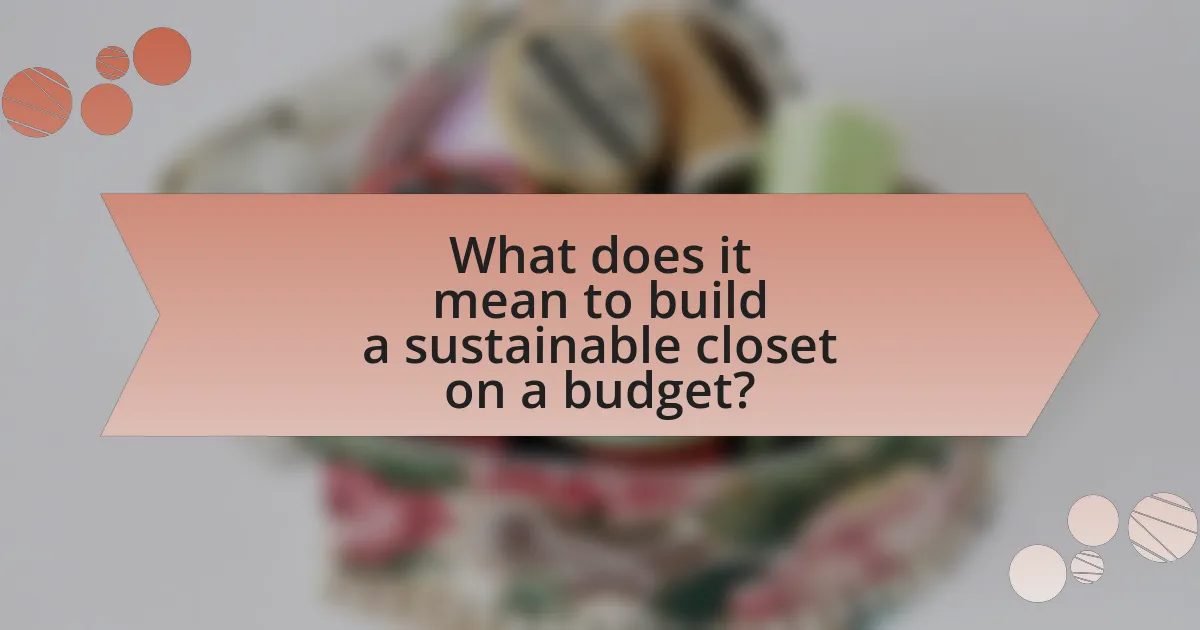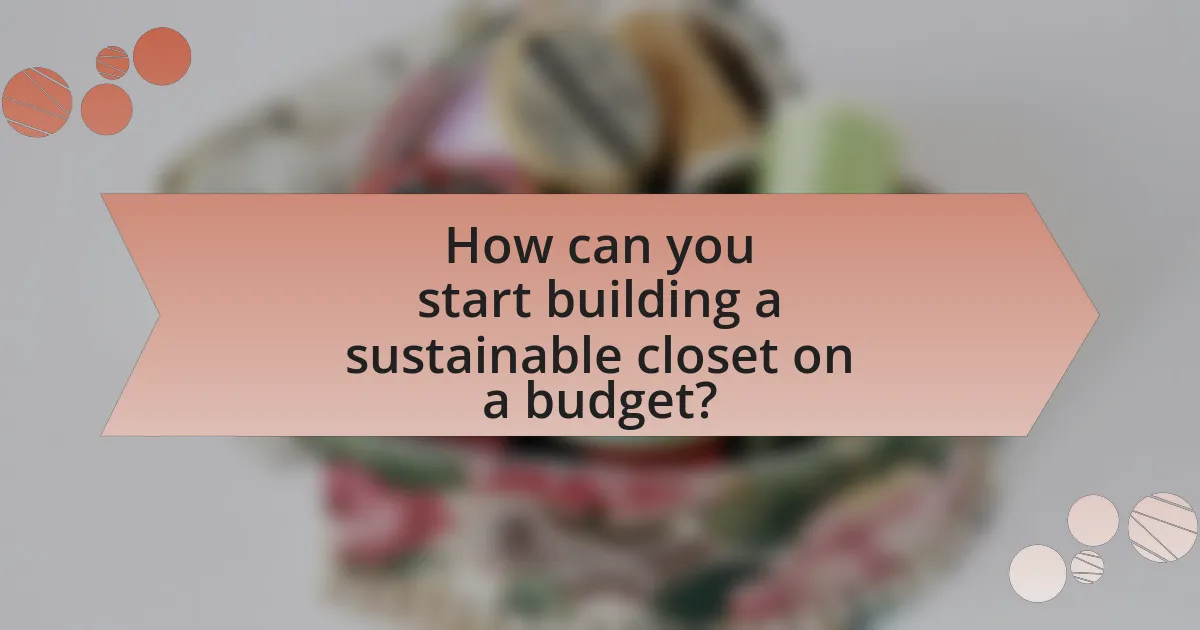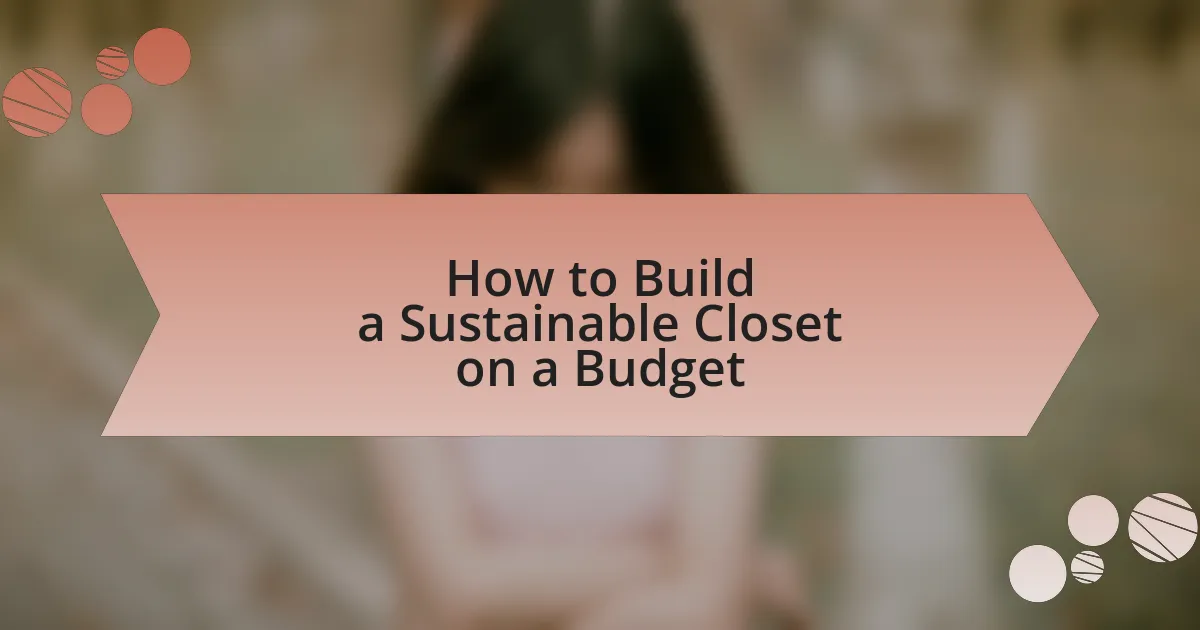Building a sustainable closet on a budget involves creating a wardrobe that emphasizes eco-friendly materials and ethical production while remaining financially accessible. Key principles of sustainable fashion include ethical production, resource conservation, and circularity, which collectively aim to minimize environmental impact and promote social responsibility. The article addresses the challenges of financial constraints in making sustainable choices, misconceptions about the cost of sustainable clothing, and practical strategies for shopping sustainably, such as prioritizing second-hand items and assessing one’s current wardrobe. Additionally, it highlights the importance of mindful purchasing and offers tips for maintaining clothing quality to extend the lifespan of garments.

What does it mean to build a sustainable closet on a budget?
Building a sustainable closet on a budget means curating a wardrobe that prioritizes eco-friendly materials and ethical production while remaining financially accessible. This involves selecting high-quality, versatile pieces that can be mixed and matched, opting for second-hand or vintage clothing to reduce waste, and supporting brands that practice sustainability without overspending. Research indicates that the fashion industry is responsible for 10% of global carbon emissions, highlighting the importance of conscious consumer choices in reducing environmental impact. By focusing on these strategies, individuals can create a sustainable closet that aligns with both their values and financial constraints.
How can sustainability be defined in the context of fashion?
Sustainability in the context of fashion can be defined as the practice of creating and consuming clothing in a manner that minimizes environmental impact and promotes social responsibility. This includes using eco-friendly materials, reducing waste through recycling and upcycling, and ensuring fair labor practices throughout the supply chain. For instance, the Global Fashion Agenda’s 2021 report highlights that the fashion industry is responsible for 10% of global carbon emissions, emphasizing the urgent need for sustainable practices to mitigate climate change.
What are the key principles of sustainable fashion?
The key principles of sustainable fashion include ethical production, resource conservation, and circularity. Ethical production emphasizes fair labor practices and transparency in the supply chain, ensuring that workers are treated fairly and compensated adequately. Resource conservation focuses on minimizing environmental impact through the use of sustainable materials, reducing waste, and lowering carbon emissions during production. Circularity promotes the idea of reusing and recycling garments to extend their lifecycle, thereby reducing the need for new resources and minimizing landfill waste. These principles are supported by various studies, such as the 2021 report by the Ellen MacArthur Foundation, which highlights the environmental benefits of circular fashion practices.
Why is sustainability important for the environment?
Sustainability is important for the environment because it promotes the responsible use of resources, ensuring that ecosystems remain healthy and functional. By adopting sustainable practices, such as reducing waste and conserving energy, we can mitigate climate change, preserve biodiversity, and protect natural habitats. For instance, according to the United Nations, sustainable development can help reduce greenhouse gas emissions by up to 70% by 2050, which is crucial for combating global warming. This demonstrates that sustainability directly contributes to environmental health and resilience.
What are the challenges of building a sustainable closet on a budget?
Building a sustainable closet on a budget presents challenges such as limited access to affordable sustainable materials and the higher initial costs of eco-friendly brands. Many sustainable clothing options, while beneficial for the environment, often come with a price premium due to ethical production practices and quality materials. Additionally, consumers may struggle to find local sources for second-hand or upcycled clothing, which can limit options for budget-friendly sustainable choices. According to a 2021 report by the Ellen MacArthur Foundation, the fast fashion industry contributes significantly to environmental degradation, making it crucial for consumers to seek sustainable alternatives, yet the financial barriers can deter them from making these choices.
How can financial constraints impact sustainable choices?
Financial constraints significantly limit individuals’ ability to make sustainable choices. When budgets are tight, consumers often prioritize immediate needs over long-term sustainability, leading to decisions that favor cheaper, less eco-friendly options. For instance, a study by the World Economic Forum indicates that 66% of consumers cite price as a primary factor in purchasing decisions, often resulting in the selection of fast fashion items that are less sustainable. This trend demonstrates that financial limitations can hinder the adoption of environmentally friendly products, as individuals may opt for lower-cost alternatives that do not align with sustainable practices.
What misconceptions exist about sustainable fashion and budgeting?
A common misconception about sustainable fashion and budgeting is that sustainable clothing is always more expensive than fast fashion. In reality, while some sustainable brands may have higher upfront costs, investing in quality pieces can lead to long-term savings due to their durability and timelessness. According to a study by the Ellen MacArthur Foundation, the fashion industry could save $160 billion annually by shifting towards a circular economy, which emphasizes sustainability and longevity in clothing. This indicates that sustainable fashion can be budget-friendly when considering the overall lifecycle of garments.

How can you start building a sustainable closet on a budget?
To start building a sustainable closet on a budget, prioritize purchasing second-hand clothing from thrift stores or online resale platforms. This approach not only reduces waste but also saves money; for instance, buying second-hand can be up to 70% cheaper than buying new items. Additionally, focus on versatile, high-quality pieces that can be mixed and matched, which extends the lifespan of your wardrobe. Research indicates that the fashion industry is responsible for 10% of global carbon emissions, highlighting the importance of sustainable practices. By choosing second-hand and quality items, you contribute to reducing this impact while staying within budget.
What steps should you take to assess your current wardrobe?
To assess your current wardrobe, start by emptying your closet and sorting items into categories such as keep, donate, and discard. This method allows for a clear evaluation of what you own and helps identify pieces that are worn out or no longer fit your style. Next, evaluate each item based on its condition, fit, and how often you wear it, which can be guided by the 80/20 rule, suggesting that 80% of your outfits come from 20% of your clothing. Finally, take inventory of the items you decide to keep, ensuring they align with your personal style and needs, which supports building a sustainable closet by focusing on quality over quantity.
How can you identify which items to keep or donate?
To identify which items to keep or donate, assess each item’s frequency of use, emotional value, and condition. Items that are used regularly, hold significant sentimental value, or are in good condition should be kept. Conversely, items that have not been worn in the past year, do not fit, or are damaged should be considered for donation. Research indicates that decluttering can lead to improved mental well-being, as noted in a study by the University of California, which found that individuals who decluttered reported lower stress levels.
What criteria should you use to evaluate your clothing’s sustainability?
To evaluate your clothing’s sustainability, consider criteria such as material sourcing, production processes, labor practices, and end-of-life options. Sustainable clothing typically uses organic or recycled materials, which reduce environmental impact. For instance, organic cotton farming uses 91% less water than conventional methods, according to the Textile Exchange. Additionally, ethical production processes that ensure fair labor practices contribute to sustainability; brands certified by Fair Trade adhere to these standards. Finally, consider the garment’s end-of-life options, such as biodegradability or recyclability, which can significantly reduce landfill waste.
What strategies can help you shop sustainably on a budget?
To shop sustainably on a budget, prioritize second-hand shopping, which significantly reduces waste and often costs less than new items. Thrift stores, online resale platforms, and clothing swaps provide access to quality clothing at lower prices while promoting a circular economy. According to a report by the Ellen MacArthur Foundation, extending the life of clothing by just nine months can reduce carbon, water, and waste footprints by 20-30%. Additionally, create a shopping list to avoid impulse purchases and focus on versatile, timeless pieces that can be mixed and matched, further maximizing your budget and minimizing environmental impact.
How can thrift shopping contribute to a sustainable closet?
Thrift shopping contributes to a sustainable closet by promoting the reuse of clothing, which reduces waste and the demand for new garment production. By purchasing second-hand items, consumers extend the lifecycle of clothing, thereby minimizing the environmental impact associated with manufacturing, such as water usage and carbon emissions. According to the Environmental Protection Agency, textile waste accounts for approximately 9.2 million tons in landfills annually, highlighting the importance of reusing garments to mitigate this issue. Additionally, thrift shopping supports local economies and charitable organizations, further enhancing its sustainability impact.
What are the benefits of swapping clothes with friends?
Swapping clothes with friends offers several benefits, including cost savings, sustainability, and variety in wardrobe options. By exchanging clothing, individuals can refresh their style without spending money, as they access new pieces without purchasing them. This practice promotes sustainability by reducing waste and the demand for fast fashion, which is responsible for significant environmental harm; for instance, the fashion industry contributes to 10% of global carbon emissions. Additionally, swapping clothes fosters social connections and strengthens friendships, as it encourages collaboration and sharing among peers.

What are the best practices for maintaining a sustainable closet?
The best practices for maintaining a sustainable closet include prioritizing quality over quantity, opting for versatile pieces, and regularly assessing your wardrobe. Prioritizing quality ensures that clothing lasts longer, reducing the need for frequent replacements; for instance, garments made from organic cotton or recycled materials often have a lower environmental impact. Choosing versatile pieces allows for multiple outfit combinations, minimizing the total number of items needed. Regularly assessing your wardrobe helps identify items that are no longer worn, enabling responsible donation or recycling, which contributes to reducing textile waste. According to the Ellen MacArthur Foundation, extending the life of clothing by just nine months can reduce carbon, water, and waste footprints by around 20-30%.
How can you care for your clothes to extend their lifespan?
To extend the lifespan of your clothes, wash them in cold water and air dry whenever possible. Washing in cold water reduces energy consumption and minimizes fabric wear, while air drying prevents shrinkage and damage from high heat. According to the U.S. Department of Energy, using cold water can save up to 90% of the energy used for heating water, making it an eco-friendly choice that also preserves clothing quality. Additionally, storing clothes properly by keeping them in a cool, dry place and using padded hangers for delicate items can prevent stretching and damage, further enhancing their longevity.
What washing and drying techniques are most sustainable?
The most sustainable washing and drying techniques include using cold water for washing, air drying clothes, and utilizing energy-efficient appliances. Washing clothes in cold water reduces energy consumption by approximately 90% compared to hot water washing, as heating water accounts for a significant portion of energy use in laundry. Air drying eliminates the need for electricity altogether, further decreasing carbon emissions. Additionally, energy-efficient washing machines and dryers are designed to use less water and energy, with models certified by ENERGY STAR typically using 25% less energy and 33% less water than standard models. These practices collectively contribute to a more sustainable laundry routine.
How can proper storage help maintain clothing quality?
Proper storage helps maintain clothing quality by preventing damage from environmental factors such as moisture, light, and pests. When clothing is stored in a cool, dry, and dark environment, it reduces the risk of mold growth, fading, and deterioration of fibers. For instance, using breathable garment bags instead of plastic can prevent moisture buildup, which is crucial for preserving fabrics like wool and silk. Additionally, organizing clothes to avoid overcrowding minimizes creasing and allows for better air circulation, further protecting the garments. Studies indicate that proper storage techniques can extend the lifespan of clothing by up to 30%, highlighting the importance of effective storage solutions in maintaining clothing quality.
What are some tips for making sustainable fashion choices in the future?
To make sustainable fashion choices in the future, prioritize purchasing from brands that use eco-friendly materials and ethical labor practices. Research shows that the fashion industry is responsible for 10% of global carbon emissions, highlighting the importance of supporting sustainable brands. Additionally, consider buying second-hand clothing, as it reduces waste and extends the lifecycle of garments. According to the Environmental Protection Agency, textile recycling can save 1.5 billion pounds of waste from landfills annually. Lastly, focus on quality over quantity by investing in timeless pieces that will last longer, thereby reducing the need for frequent replacements.
How can you stay informed about sustainable brands and practices?
To stay informed about sustainable brands and practices, regularly follow reputable sustainability-focused websites and publications such as Eco Warrior Princess and Sustainable Brands. These platforms provide up-to-date information on eco-friendly brands, sustainable fashion trends, and best practices in the industry. Additionally, subscribing to newsletters from organizations like the Sustainable Apparel Coalition can offer insights and updates directly to your inbox. Engaging with social media accounts of sustainable brands and influencers also helps in receiving real-time information and community discussions on sustainable practices.
What role does mindful purchasing play in sustainable fashion?
Mindful purchasing plays a crucial role in sustainable fashion by encouraging consumers to make informed choices that prioritize environmental and social responsibility. This approach reduces waste and promotes ethical production practices, as consumers are more likely to support brands that align with their values. Research indicates that mindful purchasing can lead to a significant decrease in the demand for fast fashion, which is responsible for approximately 10% of global carbon emissions and substantial textile waste. By choosing quality over quantity and considering the lifecycle of products, mindful consumers contribute to a more sustainable fashion industry.
What practical tips can help you build a sustainable closet on a budget?
To build a sustainable closet on a budget, prioritize thrift shopping and second-hand clothing. Thrift stores and online resale platforms offer high-quality, gently used items at a fraction of retail prices, reducing waste and promoting sustainability. According to a study by the Environmental Protection Agency, extending the life of clothing by just nine months can reduce carbon, water, and waste footprints by 20-30%. Additionally, focus on versatile, timeless pieces that can be mixed and matched, which minimizes the need for excessive purchases. Implementing a capsule wardrobe approach can further streamline your closet while maintaining style and sustainability.
